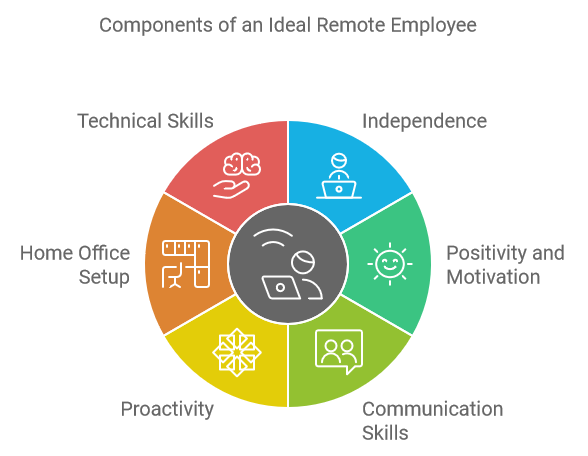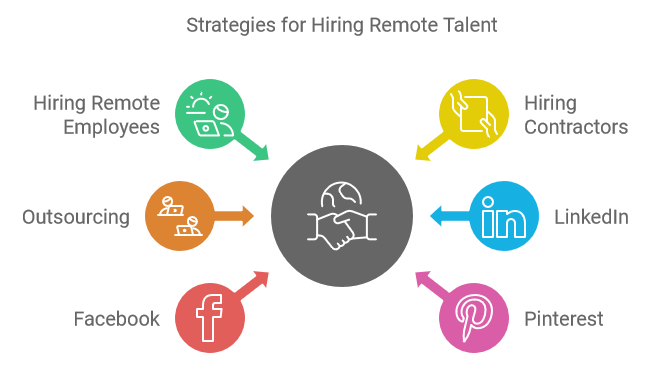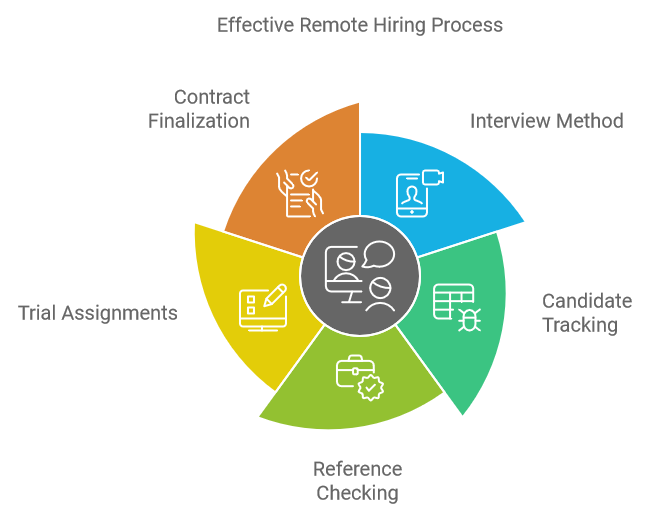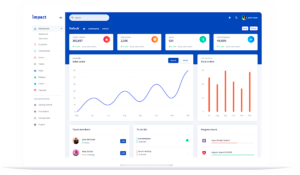Hiring remote employees for your small business
In this article, you will learn about billable hours tracking and how it helps professional services firms in maximizing profits.
11 min read
Small businesses have been hiring remote employees to get access to talent and save costs. Hiring remote employees has many benefits:
- Access to best talent irrespective of your business location
- Savings of up to 30% on office and overhead costs
- 20-50% savings on wages if you hire remote employees in a less expensive city or country
In a poll we conducted sometime back, business owners said that the most important benefit of hiring remote employees was increased access to talent. Hiring remote employees allowed them to find the best talent irrespective of local labor market conditions. Many small businesses in US metro areas hire in smaller US cities or in another country to overcome talent shortage in their cities.
Since remote employees work from home, companies hiring them save on office and infrastructure costs. There is no office rent to pay or computer to buy. Companies can save on benefits and other overheads if they hire in another country.
Businesses in the US, UK and Australia reported saving up to 50% on employee costs by hiring workers in India and the Philippines. Most of these companies hire remote developers, marketers and back office roles.
While there are significant benefits to hiring remote employees, it’s not without its share of challenges. Most businesses in our survey said that hiring the right remote employee is the biggest challenge.
Hiring remote employees needs a different plan than hiring office employees. At a high level, the process looks similar. You create the job profile, source candidates, interview, and select the right person for the job. The difference lies in how you do these activities.
You cannot supervise and monitor a remote employee the way you can supervise an office worker. You can’t walk up to their desk and check on their work. You can’t talk to them whenever you want to. So you need right processes and tools for managing remote employees.
In this post, we discuss a three-step process for hiring remote employees for your business:
- Create ideal remote employee profile
- Source right remote applicants for the job
- Hire your ideal remote employee

Create ideal remote employee profile

The first step in hiring a remote employee is to create the profile of the ideal person for the job.
Not everyone can be an effective remote worker. Even if a person has the skills and knowledge for the job role, the person may not be a good remote employee. While everyone loves the flexibility that comes with working remotely, only few haves the attitude and discipline to be productive as a remote employee.
When hiring a remote employee for your business, look for a person who:
- Can work independently without the need for detailed instructions or hand holding
- Is positive and motivated
- Is a good listener and communicator
- Works proactively
- Has the right home office set up
Include these points in your ideal candidate profile along with required technical skills. After you’ve created the job profile, it’s time to decide how you will evaluate applicants. You probably have a standard test or interview questions to test technical skills. But soft skills needed to be a remote employee are harder to test.
Consider asking following questions to applicants to decide if they will be a good remote worker:
- What’s your motivation for working remotely?
- How long have you worked remotely?
- Which tools have you used to manage your work?
- What’s your home office set up?
- What challenges have you faced in working remotely and how have you solved them?
- Ask for examples when the person showed self-motivation to finish a task
Check out this site for more questions to ask while hiring remote workers.
After you have created a plan for testing technical skill and remote work aptitude, move on to sourcing candidates to interview.
Source right remote applicants for the job

You can fill the job by:
- Hiring a remote employee on your payroll
- Hiring a remote worker on contract or as an hourly worker
- Outsourcing to another company
The option you choose depends on your specific business needs. Generally, it’s easier to hire a contractor if the person is in a different country or tax jurisdiction than yours. You don’t have to comply with labor laws, payroll, tax and insurance issues that come with hiring an employee in a different state or country. It’s also easier to let go a contractor than an employee in most countries.
If you plan on hiring multiple remote employees for your business but don’t want the trouble of managing them, then outsourcing is a good option. You can find many good outsourcing companies in India, Philippines and other places that provide the type of service you need. But outsourcing may be more expensive than hiring a remote employee as the outsourcing company will need to have a margin on top of employee cost.
In this post, we focus on hiring remote employees and contractors. There are many websites where you can find good candidates for your job:
LinkedIn: Free to Use With Option for Paid Job Listing
LinkedIn is the ideal recruitment tool due to its global reach. If you have the budget, you can post a job advertisement on LinkedIn Jobs.
But you can spread your message far and wide using LinkedIn even without posting an ad. All you need is some time and a bit of creativity.
The first step in using LinkedIn to hire a remote employee is to post the job opening as your status update on LinkedIn. Describe the job and profile of your ideal candidate. Include a link to the page where people can apply. If you don’t have a form on your site, just ask interested candidates to send you a private message on LinkedIn.
You should also post the opening on popular groups related to your industry on LinkedIn. Most groups have guidelines to follow for posting jobs so make sure you read group rules before posting your job. Postings in LinkedIn Groups generally get a better response than postings on your profile page. Posting in groups puts your job in front of a large, targeted audience.
As people Like, Share or Comment on your post, more people around the world see and respond to it. If done well, you can get dozens of qualified applications for the job.
Facebook: Free to Use
Most business owners don’t look at Facebook as a recruitment tool. As a small business owner, you have probably used Facebook for marketing. But you can also use it for hiring remote workers.
Facebook Groups are one of the best tools for hiring. Almost every major city in the world has a Facebook jobs group. Thousands of people join these groups in search of a job. You can post your job for free in most Facebook groups.
Just like LinkedIn, you can find Facebook Groups related to your industry or job function and post your job there. Many people in these groups are looking for gigs or remote work. They can be an ideal hire for your business since they are already looking at working remotely and are motivated workers.
Pinterest: Free to Use
Pinterest is a great place to find talent if you are looking to hire remote marketers. Marketers, especially of the creative variety, love to hang out on Pinterest. If you are looking to hire a designer, video maker / editor or content writer, Pinterest is a great place to post your job.
Create an attractive image and/or video and post on Pinterest.
Upwork: Paid
Upwork (formerly Elance and oDesk) is world’s largest marketplace for freelancers, contractors and small outsourcing firms. You can find a worker with almost any skillset on Upwork. Since Upwork is focused on freelance work, it’s project driven.
Hiring remote workers on Upwork is easy:
- Post your project
- Freelancers/companies bid for your work
- You review and select the best candidate from the list of bidders
When posting your project, be as specific and detailed about the job to be done and the results you expect from the remote employee. You should include both hard and soft skills needed to do the job. Ask bidders to share their previous work history or portfolio.
You should be open to hiring both experienced and new freelancers on Upwork in order to find the right talent at a good price.
Existing or experienced Upwork freelancers have a portfolio with client reviews. So it’s easier to assess them. Workers with a solid portfolio of work on Upwork generally charge more than new freelancers.
If you want a good deal, look for workers who are new to Upwork. New freelancers join Upwork every day. They don’t have any feedback or portfolio on Upwork. So they are generally willing to work at a discounted rate to build a track record there.
But evaluating them is a bit tricky. Ask them to share their work experience. These could be from past employers or work done elsewhere. Insist on references you can talk to validate their skill set and work ethics.
Pro-tip for hiring on Upwork
A pro tip for finding the right remote worker on Upwork is to first post a small, test project. For example, if you want to hire an SEO person, post a project to build 10 links in a week. Mention in your project that you are looking for a long term hire and the current project is to test potential workers.
Hire multiple workers for your test project. By creating a small project, you can keep your costs down and afford to test multiple remote workers. After the workers finish the project, you can evaluate the work and select the best one for ongoing work.
While Upwork is a good place for hiring remote workers, it charges a steep fee from both employers and freelancers.
As the buyer, you pay a 2.75% fee to Upwork for using the platform. Upwork adds this fee to the contracted amount when billing you. While this sounds like a small fee, it can quickly add up if you hire multiple workers or hire someone for the long term. For example, if you hire a remote employee for $1000 per month, you will pay Upwork $27.5 every month in fees.
Upwork also collects a monthly fee plus 10-20% of contract amount from the freelancer. For repeat project, Freelancer will have to pay 10% of the billed amount. Most freelancers include this fee in their bid amount so the buyer ends up paying the bulk of the transaction fee on Upwork. So for a $1000 work, Upwork will collect $157.5 first month and $127.5 in following months. That’s a lot of money to pay every month for one remote employee every.
If you don’t want to pay $100 or more every month in fees, use Upwork to find remote employees using a one-off project. Then hire the worker directly, bypassing Upwork.
Upwork has a time tracking tool that gives you visibility into your remote employee’s work. But you can a good time tracking software like HiveDesk for much less than the average monthly fee you have to pay Upwork.
Hire your ideal remote employee

Interview and reference checking is the final step in hiring remote employees. Since you cannot meet remote candidates in person, you will have to interview them over the phone or internet. I recommend you use Zoom or Skype to do a video interview. I like video interviews because
- I can look for visual clues to evaluate the person
- Seeing someone is a powerful way to connect with the person
- Video calls are a great way to test the home office setup of the applicant
I prefer Zoom over Skype for one-off meetings like interviews since I don’t need to add the person to my contact list. I don’t like adding dozens of people to my Skype contact list unless I intend to connect with them on a regular basis. With Zoom, I just email a link that the candidate can click to join the meeting.
If your job posting gets dozens of responses, as it should, you will need a way to track the candidates. If you can afford, sign up for an applicant tracking system. You can also use a spreadsheet or Google sheets to track candidates. Keep updating the spreadsheet as you review the resume/portfolio and interview the candidates.
At the end of the interview, ask the candidate for references. It’s a good way to find out if the person will be a good fit as a remote employee.
If you have more than one candidate you like, consider giving each of them a small assignment.
For example, if you are hiring a content writer, ask each of them to write a short blog post. It can be as small as 500 words. The idea is to check if the person can structure thoughts and write well.
This approach reduces the risk of hiring a wrong remote employee. You may have to spend a little extra on trial assignments but it’s much better than hiring the wrong remote worker. The trial assignment is by far the best way to judge the quality of a remote employee. It’s great for checking both technical skills and ability to work remotely.
After the trial assignment, select the person you like most, finalize terms of contract/job and sign the contract. Make sure you receive a signed copy of the contract before the remote employee starts working.
If you liked this post, let us know. You can also share your experience in hiring remote workers for your business.


